






       |
|
|
|
|
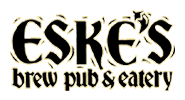  |
|
MONTHLY CALENDAR Dinner Specials Live Music Special Events ESKE'S BEER Beer-101 Eske's Beer Index Tour the Brewery PUB FARE The Menu Weekly Specials LIVE MUSIC The Usual Suspects Past Events Wanna Play? TAOS FAVORITES Where to Stay What to Do SHOP Stuff for Sale T-shirts, Hats and More! COME ON IN How to Find Us How to Reach Us HOME Eske's Brew Pub & Eatery 106 Des Georges Ln Taos, NM 87571 (505) 758-1517 eskes@laplaza.org |
|
So you want to see where all these magnificent beers are created? Well, follow me downstairs to the brewery 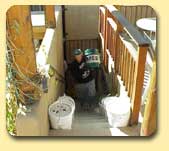 for a quick peak at the Master Brewer and the equipment he uses to magically convert grain, hops, yeast, and water into, your friend and mine, BEER. for a quick peak at the Master Brewer and the equipment he uses to magically convert grain, hops, yeast, and water into, your friend and mine, BEER.
Grain Selection The first step in the brewing process is to select the malted barley that will be used. There are several different types of barley available ranging from very light pale malt used as a base for most styles, to the dark, well roasted chocolate malts used in the darker styles such as porter and stout. The grain is then ground to break the husks open, facilitating the conversion process called Mashing. The Mash The grain is combined with the 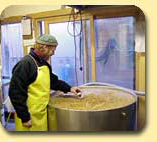 appropriate amount of hot water, stirred until all the grain is evenly distributed, and maintained at a certain temperature for about an hour and a half. Maintaining the proper temperature range allows the enzymes in the grain to fully convert the starchy part of the grain to fermentable sugars. Once conversion is complete the liquid is drained out of the bottom of the Mash Tun and recirculated through the grain several times. This process helps clarify the liquid by taking advantage of the natural filter created by the now empty husks. When sufficient clarity has been achieved appropriate amount of hot water, stirred until all the grain is evenly distributed, and maintained at a certain temperature for about an hour and a half. Maintaining the proper temperature range allows the enzymes in the grain to fully convert the starchy part of the grain to fermentable sugars. Once conversion is complete the liquid is drained out of the bottom of the Mash Tun and recirculated through the grain several times. This process helps clarify the liquid by taking advantage of the natural filter created by the now empty husks. When sufficient clarity has been achieved 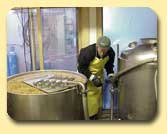 the sparge arm is attached and additional hot water is added to the mash tun helping to flush out all the fermentable sugars. The liquid, now called The Wort, is runoff into the Brew Kettle where it is boiled for another hour and a half. the sparge arm is attached and additional hot water is added to the mash tun helping to flush out all the fermentable sugars. The liquid, now called The Wort, is runoff into the Brew Kettle where it is boiled for another hour and a half.
Boiling During the boil all sorts of  chemical changes are taking place. Proteins are coagulating and precipitating out, unwanted bacteria and other organic contaminants are purged, and of course the bittering hops are imparting their alpha acid resins to the wort. Hops are added to the boil at various times for each recipe, the degree of hopping needed varies with the strength of the "body" of the beer. chemical changes are taking place. Proteins are coagulating and precipitating out, unwanted bacteria and other organic contaminants are purged, and of course the bittering hops are imparting their alpha acid resins to the wort. Hops are added to the boil at various times for each recipe, the degree of hopping needed varies with the strength of the "body" of the beer. 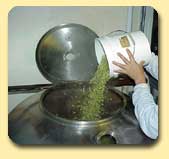 The hops added during the boil are for bittering the beer. At Eskes we also dry hop the beer after the fermentation has occurred, taking advantage of the aromatic quality of the hops. Mesa Pale Ale is a good example of a dry hopped beer. The hops added during the boil are for bittering the beer. At Eskes we also dry hop the beer after the fermentation has occurred, taking advantage of the aromatic quality of the hops. Mesa Pale Ale is a good example of a dry hopped beer.
Fermentation After the boil, the wort is chilled, using our state of the art Wort Chiller, then pumped into our fermenters (actually converted serving tanks) where it will undergo the modern day alchemy we call fermentation. The appropriate yeast is added to the mixture and the tank is sealed with a blowoff valve to allow the Carbon dioxide to escape. 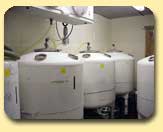 During Fermentation the yeast is greedily consuming all the sugar it can while producing alcohol and CO2 as by products. This process takes between 10 and 14 days and is monitored carefully by the brewer. The proper temperature range for the yeast must be maintained so the beer can fully ferment. During Fermentation the yeast is greedily consuming all the sugar it can while producing alcohol and CO2 as by products. This process takes between 10 and 14 days and is monitored carefully by the brewer. The proper temperature range for the yeast must be maintained so the beer can fully ferment.
Well that about wraps up the brewing process, after the fermentation is completed the beer is kegged, chilled, and served up fresh to the thirsty public! Click here for a look at the various beers brewed here at Eske's. Return to the top of this page. |